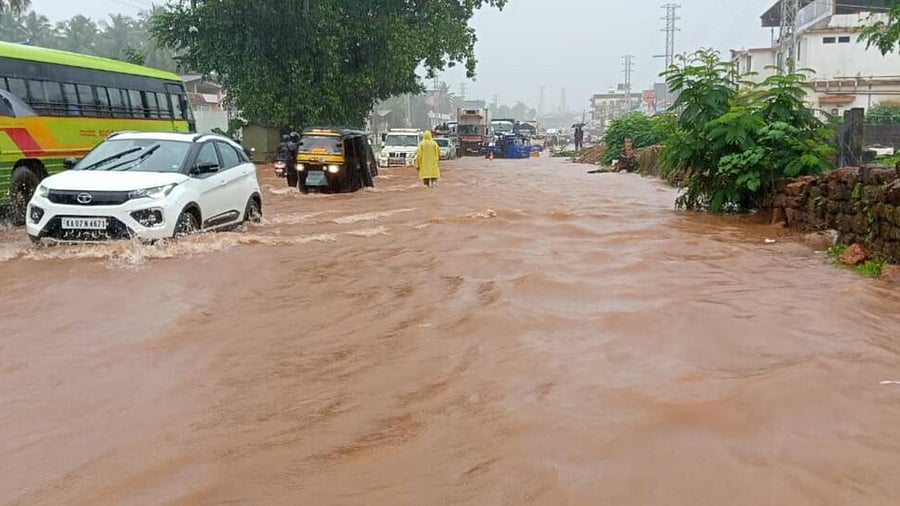
India has already seen several instances of urban flooding in 2023 — from Bengaluru to Gurugram — with the latest being Mumbai within a day of the monsoon’s arrival. Urban flooding has become a recurring and alarming issue in Indian cities every Monsoon.
In 2022, unprecedented and relentless rains, reported to be the third heaviest ever in Bengaluru, brought India’s ‘Silicon Valley’ to its knees. Climate Change-driven changes to rainfall patterns, coupled with rapid and often unplanned urbanisation affecting the natural drainage are resulting in increased runoff, thereby intensifying flooding and waterlogging across cities in India.
Analysis by the Council on Energy, Environment and Water (CEEW) shows that over 45 per cent of districts in India have undergone concerning changes to landscape. Cities, in particular, have witnessed disrupting natural drainage patterns and encroachment on vital water bodies such as lakes and ponds that were originally intended to absorb stormwater. For instance, Hyderabad, home to 400 lakes and 48 flood-absorbing tanks in 1929, has undergone drastic land-use changes due to rapid urbanisation, and now has only 169 lakes.
Moreover, inadequate stormwater and sewerage infrastructure and fragmented governance systems with multiple institutions contribute significantly to urban flooding. The limited capacity for wastewater treatment further exacerbates the situation during the heavy rainfall events, leading to adverse health impacts due to the mixing of sewage and floodwater.
Implementing comprehensive stormwater management plans to tackle flood risk and promoting sustainable water management in urban areas, especially during the Monsoon season, is crucial. For this, we recommend four steps.
Adopt a resilient design that integrates water cycle management in urban planning:
This should involve restoring traditional water bodies, revitalising lakes, building artificial lakes, and developing green infrastructure such as rain gardens. These measures will enhance permeability, create open spaces, and effectively manage stormwater runoff. Some Indian cities are already leading the way. For instance, Delhi aims to rejuvenate 500 lakes within five years through its ‘City of Lakes’ initiative. Bhopal has a green-blue smart city plan that focuses on sustainable water management, and mainstreaming wastewater treatment and reuse. Similarly, Chennai, Mumbai, and Kochi are developing dedicated sponge city roadmaps, which would enhance the capacity of the city landscape to absorb, store excess rainwater, and recharge groundwater.
Cities must develop a comprehensive stormwater drainage master plan:
Most Indian cities do not have separate stormwater and sewage drains. NITI Aayog reports that 65 per cent of urban settlements even lack a city master plan. In cities where there are plans, they are not in sync with the city's land use patterns and drainage infrastructure. For example, Bengaluru requires an additional 658 kilometres of sewage drains and remodelling of existing drainage systems. Some cities are taking positive steps, like Guwahati, which under its flood-free mission has implemented measures such as constructing alternative stormwater drains in the highly flood-exposed Bharalu basin.
Strengthen the water and sanitation health (WASH) infrastructure:
One of the important steps in this is to establish better links between centralised sewer systems and decentralised wastewater treatment. In India, the decentralised sewer system is not mainstreamed, and the centralised system faces challenges like limited coverage (less than 35 per cent) and poor maintenance. During heavy rainfall, untreated wastewater mixes with stormwater and overflows. Developing a balanced approach that combines on-site and off-site treatment is essential for effective wastewater management. Treating wastewater has multiple benefits, including reducing greenhouse gas emissions and creating economic value. According to a CEEW study, if wastewater had been treated in India in 2021, it could have resulted in a reduction of 1.3 million tonnes of greenhouse gas emissions. Additionally, the treated wastewater could have had a market value of Rs 630 million.
Assess flood-carrying capacity of Indian cities and prepare urban flood risk database:
This assessment would involve analysing the capacity of cities to handle flooding by determining the extent of inundation under various precipitation intensities and duration. Such information would facilitate the calibration of forecasting models, enabling timely issuance of early warnings and alerts based on regional thresholds. The inundation probability forecasts should be integrated with the Urban Meteorological Services dashboard of the Indian Meteorological Department (IMD), which provides spatial forecasts of weather at a week's time. For example, the Tamil Nadu State Disaster Management Authority, last year piloted a spatial decision support system based on real-time flood forecasting in Chennai, and is expected to be operational from this year onwards.
The recent launch of new disaster management schemes by the Union Home Minister marks a significant step towards addressing the issue of urban flooding. With a substantial allocation of approximately Rs 2,500 crore for seven most populous metro cities, this dedicated budget provides a unique opportunity for these cities to implement comprehensive and integrated approaches to manage urban floods.
As Climate Change makes headlines as a precursor for more frequent heavy rainfall events, effective urban flood management strategies can make Indian cities resilient.
(Kartikey Chaturvedi and Shravan Prabhu are Research Analysts at the Council on Energy, Environment and Water.)
Disclaimer: The views expressed above are the author's own. They do not necessarily reflect the views of DH.